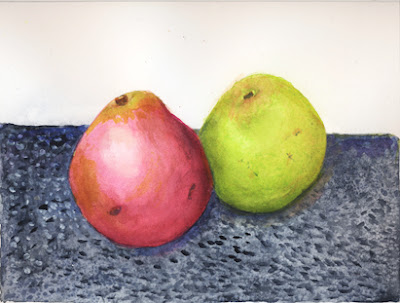 |
| Red and Green D'Anjou Pears |
March 15th, which is best-known as the Ides of
March an ominous day for Caesar in Shakespeare’s Julius Caesar, is also on a more pleasurable note National Pears
Hélène Day—not a holiday that runs trippingly off our tongues, but a day when
we can celebrate a fruit that many of us love to look at, draw, and eat. Originally from Asia, pears, have been around
a long time. Homer in the Odyssey referred to them as “a gift of
the gods.” The thousands of varieties of
pears that we know today in the United States come to us largely from
Washington, Oregon, and California.
These pears are the progeny of those brought along the Lewis and Clark
Trail to Oregon and Washington in the 1800s. While early attempts to grow pears
in the Northeast did not fare well, the combination of light, of rich volcanic
soils, and of the more European-like weather of the Northwest turned out to be
an ideal environment for pears. We are thankful for this confluence of factors
to produce the juicy, delectable, flavorful fruit so many of us enjoy. Not only that but they are healthy eating:
pears are a good source of Vitamins A and C as well as antioxidants, fiber and
potassium. The green and red D’Anjou pears, Pyrus
communis, in my drawing not only inspired my drawing, but they also ended
up as part of a salad (the green one) and as a delicious dessert (the red one)—not
quite as sweet and tasty as Pears Helene, but good anyway.
But since I mentioned it, you will have guessed that National
Pears Hélène Day comes with a recipe and it is quite decadent—warm poached
pears, vanilla ice cream, and chocolate sauce.
It was created by the famous chef Auguste Escoffier and was named after
the Offenbach opera, “La belle Hélène.”
I’m not sure if you have to listen to the music while you eat it, but it
might add a nice touch. I’m including
Nigella Lawson’s delicious take on this very
special dish: Pears Belle Helene recipe.
My drawing is a combination
watercolor of the fruit and a salt painting for the bottom half of the
drawing. To do that, I watered down the
paper (covering the area where I was going to paint the pears) and dropped in a
dark greyish blue that I had mixed from my watercolors. Then when it was wet, I sprinkled table salt
and rock salt on the paper and let it dry.
Next, I rubbed off the salt and added a few more splotches of color to
even out the page. I got this idea from
Mindy Lighthipe’s online watercolor class, which is filled with wonderful tips
on color and ways to create background interest.

